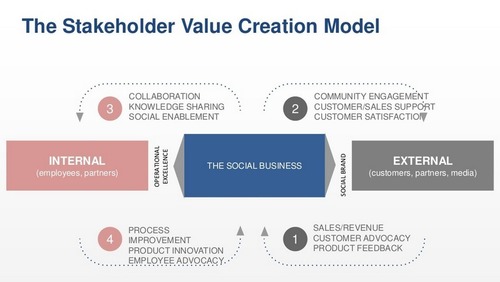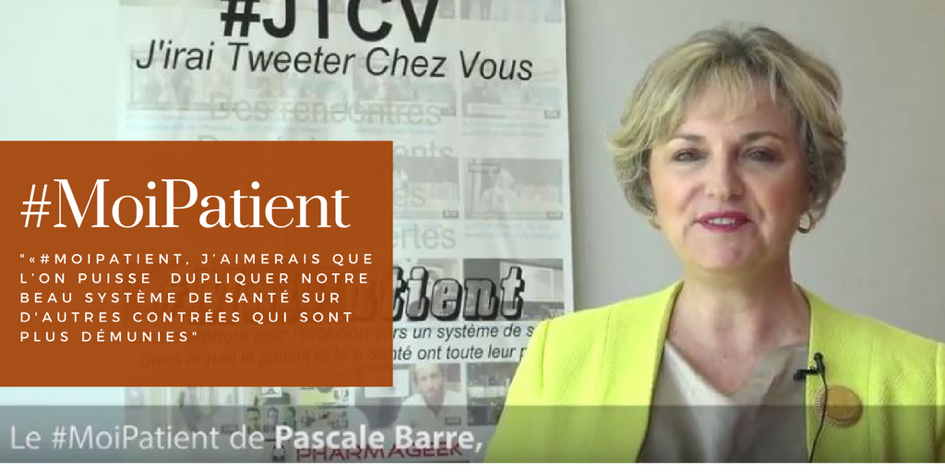Telemedicine
02/04/2014Study: Virtual reality can help treat PTSD #hcsmca #sim4health
02/04/2014How can hospitals use social media?
On Tuesday, Tabitha and I attended a half-day social media workshop. The speaker, Michael Brito, presented the concept of a Social Business Strategy, which is a communications model that relies on both internal (employees, partners) and external (customers, partners, media) in order to receive maximum value. Regardless of the size of a company, it can be extremely difficult to rationalize investing time and money in social media – especially when it can be equally difficult to know how to measure the efforts.
Frantically recording notes on my Macbook, I tried to see Michael’s presentation through the lens of health care. While many influential organizations (Mayo Clinic, Hopkins Medicine) are thriving online in social media networks, the reality is many smaller hospitals aren’t sure how they can contribute to the social streams without the guidance, budget, or understanding of how to effectively communicate to an audience.
Patients are empowered.
Though it may pain some doctors to realize it, people are trying to diagnose their symptoms online. Every year, more people turn to Google to research common symptoms, physician ratings, recovery information, and healthcare organizations. And whether or not the information gathered is completely valid, patients base next steps on their findings. The great news is social media sites can position you as an influencer if used the right way. Health care brands, physicians, and staff members can use resources available to them to educate current and future patients.
1. The health care brand
When hospitals are present and active on social media outlets, patients perceive them as cutting-edge. The problem is that too many organizations find a hard time identifying how to support marketing efforts with social media – there is no strategy fueling a return on the investment. Be Purposefully Present Being “present” online is an excellent start, but in order to make the effort worthwhile, the brand needs to tactically drive leads. Hopefully, the organization already understands the importance of generating content that will resonate with patients (current and potential) searching for a health care solution. From promoting patient videos to participating in health chats, there are countless ways available to jump into conversation and engage an audience. Social media activity should advance the efforts of a pre-existing goal of a priority service line – for example, to increase email addresses through a form on a Cardiology landing page. Be Transparently PositiveIt’s incredible to recognize the extent that some health care brands are reaching out to people who may never set foot in their facilities. I subscribe to Cleveland Clinic’s Be Well newsletter – and it’s an incredible source of health information spanning a huge array of topics. Yesterday’s newsletter featured a “supercharged oatmeal” recipe, an article about heart attack prevention, several infographics, and some advice regarding “text neck,” (which I’m probably suffering from).
My point is: I wouldn’t have subscribed if the brand hadn’t tweeted about it. Will I ever go to that specific hospital for a procedure? Maybe not, because it’s a couple states away. But imagine the effect this quality of information can have on someone who is considering Cleveland Clinic for its services. Another brand I admire for its social media engagement is Seattle Children’s Hospital. Positivity radiates from this brand’s Facebook page. The timeline is packed with encouraging stories of patients, and it truly reflects the brand’s mission to “Hope. Care. Cure.”
2. The individual doctors
Physicians are generally hesitant to create a professional social media profile and invest time in sharing their expertise. Why is this? A few reasons:
- My schedule does not allow for social media
- I don’t see the point in giving away information for free
- I don’t want to push doctor-patient boundaries
Those all seem like valid points – after all, doctors are paid to treat patients in person. But after a lot of research, I’m more convinced than ever that it is in doctors’ (and patients’) best interests for physicians to be actively communicating online.
“My schedule doesn’t allow it.” Being active online doesn’t mean you have to de-evolve into a SnapChat-ing tween. For many people, social media is one giant distraction – but for you, it is a portal into the needs of patients. Start with the platforms that fit your schedule and comfort level. That might mean tweeting links to health-related articles you have read. Even if you didn’t write the content, you can at least steer patients toward medical sources you trust.
“I don’t see the point in giving away information for free.” No one expects a physician to provide a digital diagnosis over Facebook. But general health practices? Definitely. The value of your online presence is largely graded by the quality of info you share – but value also stems from the act of listening to and engaging with patients. Caring enough about patients to share new articles (including your own, which can drive traffic to your site) is a great way to establish trust and ultimately increase patient enrollment. Discuss and share topics you’re passionate about; it will keep your patients engaged and position you as a thought leader. “I don’t want to push doctor-patient boundaries.” Roughly 20% of physicians consider online interaction with patients to be inappropriate behavior, according to a 2011 report by Quantia. However, that perception is outdated and will not be one that carries over into the future of health care. Doctors need to make it a point to bridge medical breakthroughs or stories in the media with how patients are affected. When translating your expertise online, speak to a collective audience, not one-on-one. It’s possible to expose your personality while still acting professional; just take a tip from Dr. Neal Barnard, who is constantly sharing tweets relating to his passion for healthy eating.
As for situations involving patients who feel entitled to privately contact a physician for medical advice or a diagnosis – simply deliver a canned message that asks them to contact their own provider or 911. (Hopefully that won’t happen often.) In alignment with the new expectations outlined in the Affordable Care Act, being present and active on social media will allow your brand to provide a higher level of care to your patients. Each social media channel has a specific purpose – which you can use to advance your personal image.
3. The hospital staff
The message I most appreciated at the workshop on Tuesday was the idea of training employees to become brand ambassadors. This is critical for two main reasons: 1. Employees need to understand the power of their reach. At Evolve Digital Labs, we have in place a social media policy. I signed one as soon as I started here two years ago, when there were only a handful of employees on board. There are very few restrictions – and honestly, the rules forbid actions I would avoid even without signing the contract (e.g., talking negatively about clients, other employees, and the Evolve brand itself). Still, people everywhere are terminated from their jobs because they underestimate the effect of their Tweets and Facebook posts. 2. Employees should take the initiative to promote their brand. Just as staff members can negatively impact the perception of the hospital for which they work, they also have the opportunity to positively spread brand awareness. This can be as simple as following their employer on Twitter and retweeting posts. Or promoting brand events through their personal profiles. Even scanning the social channels to find inspiration for new digital marketing initiatives can play a huge role in giving your brand an edge over competitors. Michael’s point about making employees brand ambassadors was inspiring, to say the least. It’s a notion that challenges employees to see themselves as an extension of the brand voice. It’s an empowering concept: by communicating to employees that their involvement is encouraged, brands (and not just health care brands) can expect to see a higher volume of reach.
Conclusion
The more I research how the big hospital brands are using social media channels to transfer trust, educate patients, and build a community, it’s pretty exciting to see how local hospitals can implement similar efforts on a smaller scale. Social media allows for two-way communication online, which allows for a degree of transparency that appeals to patients. Hopefully we’ll see more brands investing time and effort into reaching patients online.
See on evolvedigitallabs.com




